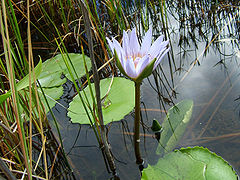This is an old revision of this page, as edited by Doctorfluffy (talk | contribs) at 07:22, 30 October 2007 (orphan). The present address (URL) is a permanent link to this revision, which may differ significantly from the current revision.
Revision as of 07:22, 30 October 2007 by Doctorfluffy (talk | contribs) (orphan)(diff) ← Previous revision | Latest revision (diff) | Newer revision → (diff)| This article does not cite any sources. Please help improve this article by adding citations to reliable sources. Unsourced material may be challenged and removed. Find sources: "Nymphaea capensis" – news · newspapers · books · scholar · JSTOR (August 2007) (Learn how and when to remove this message) |
| This article is an orphan, as no other articles link to it. Please introduce links to this page from related articles; try the Find link tool for suggestions. |
| Cape blue waterlily | |
|---|---|

| |
| Nymphaea capensis at Helderberg Nature Reserve | |
| Scientific classification | |
| Kingdom: | Plantae |
| Division: | Magnoliophyta |
| Class: | Magnoliopsida |
| Order: | Nymphaeales |
| Family: | Nymphaeaceae |
| Genus: | Nymphaea |
| Species: | N. capensis |
| Binomial name | |
| Nymphaea capensis Thunb. | |
The Cape blue water lily (Nymphaea capensis Thunb.) is an aquatic flowering plant of the family Nymphaeaceae.
It is found growing abundantly in freshwater habitats in South Africa and neighbouring countries. This plant's bulb can survive relatively long periods of time without rainfall in a dry river bed. During the rain season, as the riverbed or bog fills up, the bulb will sprout leaves and flowers.
The Cape blue water lily grows best in full sun to semi-sun and in relatively shallow water.
This plant article is a stub. You can help Misplaced Pages by expanding it. |